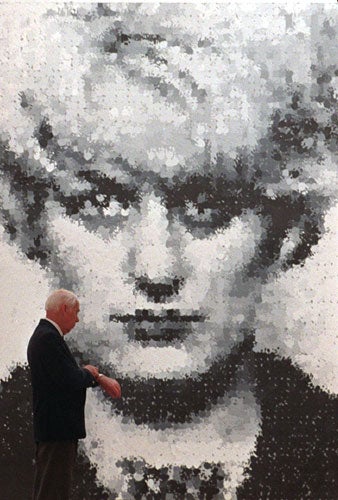From muse to artist – Hindley's anonymous work on display
Revealed: ceramic pig crafted by the Moors murderer is being exhibited in Nottingham gallery

Your support helps us to tell the story
From reproductive rights to climate change to Big Tech, The Independent is on the ground when the story is developing. Whether it's investigating the financials of Elon Musk's pro-Trump PAC or producing our latest documentary, 'The A Word', which shines a light on the American women fighting for reproductive rights, we know how important it is to parse out the facts from the messaging.
At such a critical moment in US history, we need reporters on the ground. Your donation allows us to keep sending journalists to speak to both sides of the story.
The Independent is trusted by Americans across the entire political spectrum. And unlike many other quality news outlets, we choose not to lock Americans out of our reporting and analysis with paywalls. We believe quality journalism should be available to everyone, paid for by those who can afford it.
Your support makes all the difference.For the 70,000 visitors who each year amble past a ceramic plant holder in the shape of a pig, which takes pride of place in a glass museum display cabinet in Nottingham, this artwork by a prisoner might have struck them as a charming, if kitsch, example of the healing powers of rehabilitation.
In fact, The Independent has learned that the porcelain white swine with a wasp balancing on its nose, adorned with gold paint, has a surprising history: it was made by the serial killer Myra Hindley while she served her life sentence in Durham Prison after being convicted of the Moors Murders with Ian Brady.
The work, named China Pig, was forged in the women's wing of HMP Durham around 1996, and was bought by a former governor. He donated it to the Galleries of Justice Museum in Nottingham, dedicated to prisoner art and artefacts – much to the relief of his wife who disliked the work. It has been on display there since 2005, alongside the official HM Prison Services Collection.
Bev Baker, a senior curator and archivist at the museum, said the prison governor from Durham had donated the ceramic piece four years ago after buying it from a sale in Durham. "We acquired the pig through the Retired Prison Governors' Association," said Ms Baker.
"We don't want to sensationalise or glamourise this. He bought it and donated it to us, to the relief of his wife who had hated it. I don't know if it was because she thought it was ugly or because of its associations, but she was glad to see the back of it."
The plaque next to the piece does not disclose the artist, stating: "The pig was made during a prisoner art session and was later sold to raise money for charity. The Centre was commonly known as the 'She Wing' until it closed in 2004. Some of Britain's most notorious 'Category A' inmates were held in the female centre including the murderers Myra Hindley and Rosemary West."
Tim Desmond, the chief executive of the museum, which was founded 15 years ago and won the first Gulbenkian Prize for museums and galleries, said the point of the permanent exhibition was not to create a folklore around any one infamous inmate but to illuminate prison life and history. Other exhibits include a shirt worn by one of the Kray twins; a trap door and noose from Wandsworth Prison and a list of executions including that of Derek Bentley; Oscar Wilde's door from his Reading jail cell; and handkerchiefs carrying sectarian images made by the IRA inmates of the Maze.
"We display arts and artefacts and pretty much leave it for the public to come to their own conclusions about it," Mr Desmond said. "We have a noose on display which represents the history of capital punishment, for example, and a list of people executed, but we are not saying that we approve or disapprove."
Mr Desmond added that the public was left to "infer" that the pig was made by Hindley, because "we wanted to take the sting out of it".
"Myra Hindley was in prison for decades," he added. "Part of the regime there was recreation and to get the prisoners to develop as people."
The issue of whether art should be suppressed based on the moral character of its creator stirs dispute.
Last year, the Chapman brothers sold a series of paintings by Adolf Hitler, which they had bought and then defaced. In April, the creator of an artwork at London's Royal Festival Hall, a tableau of an orchestra made from cut-up sheets of the score of Beethoven's Ninth Symphony, was revealed to be Colin Pitchfork, a double sex murderer.
Join our commenting forum
Join thought-provoking conversations, follow other Independent readers and see their replies
Comments